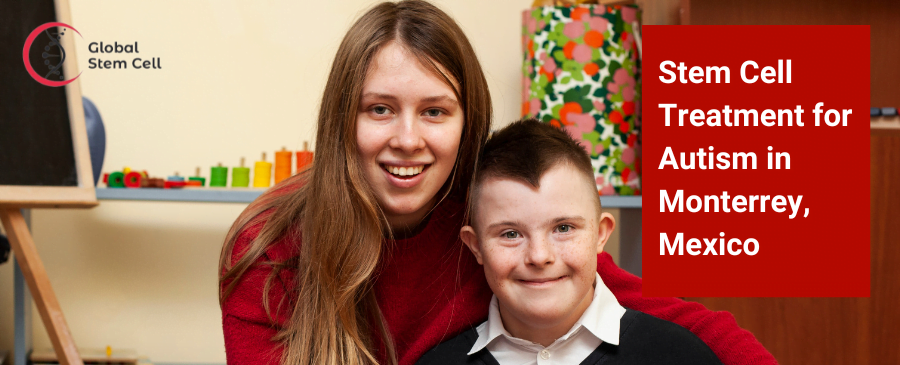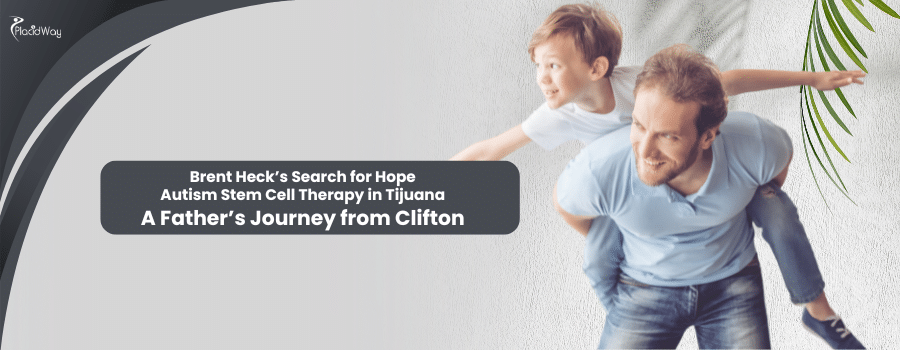Stem cell therapy has emerged as a promising treatment for various medical conditions, including autism spectrum disorder (ASD). Monterrey, Mexico, is becoming a popular destination for medical tourism, offering advanced stem cell treatments.
This guide provides an informative overview of stem cell therapy for autism in Monterrey, including types of treatments, pre- and post-treatment considerations, travel tips, costs, risks, benefits, and frequently asked questions.
Ideal Candidates for Stem Cell Treatments for Autism
Table of Content
Stem cell therapy for autism is still experimental and should be considered carefully. The ideal candidates for this treatment generally have specific characteristics that may make them more suitable for potential benefits. Here are the key factors that define an ideal candidate:
- Diagnosis: Individuals with a confirmed diagnosis of autism spectrum disorder (ASD), typically made by a qualified medical professional through comprehensive assessments.
- Age Range: While stem cell therapy has been explored in children and adults with autism, younger patients, particularly those between 4 and 12 years old, may show more significant improvements due to their ongoing brain development.
- Severity of Symptoms: Patients with moderate to severe autism symptoms who have not responded well to conventional treatments might be considered for stem cell therapy.
- Medical History: Candidates should have a detailed medical history reviewed to rule out contraindications for stem cell therapy. This includes evaluating for any co-existing medical conditions that may interfere with the treatment.
- Current Treatments: Individuals currently undergoing standard autism treatments, such as behavioral therapy or medications, can still be candidates for stem cell therapy, provided these treatments are stabilized and monitored.
- Family Support: Strong family support and a willingness to participate in follow-up evaluations and therapy sessions are crucial for the success of the treatment.
How Stem Cells Can Help with Autism
Stem cell therapy for autism is based on the potential of stem cells to repair or regenerate damaged tissues, reduce inflammation, and modulate the immune system. Here’s how stem cell therapy might help address issues associated with autism spectrum disorder (ASD):
Reducing Neuroinflammation
Mechanism: Autism is associated with chronic inflammation in the brain. Stem cells, particularly mesenchymal stem cells (MSCs), have strong anti-inflammatory properties.
Benefit: By reducing inflammation, stem cells could potentially improve neuronal function and reduce autism symptoms like irritability, hyperactivity, and social withdrawal.
Modulating the Immune System
Mechanism: There is evidence suggesting that immune system dysregulation plays a role in autism. Stem cells can modulate the immune response.
Benefit: By normalizing immune system function, stem cells might help alleviate some symptoms of autism.
Repairing Neural Damage
Mechanism: Some types of stem cells, like neural stem cells (NSCs), have the ability to differentiate into various types of brain cells, including neurons.
Benefit: These cells could potentially repair or replace damaged neurons, improving cognitive functions and behavioral outcomes.
Promoting Synaptic Connectivity
Mechanism: Stem cells can release trophic factors (growth factors) that promote the growth and connectivity of neurons.
Benefit: Improved synaptic connectivity can enhance communication between neurons, potentially improving cognitive and social functions.
Supporting Gut-Brain Axis
Mechanism: Autism has been linked to gastrointestinal issues, and the gut-brain axis plays a role in neurological health. Stem cells might help in repairing gut lining and reducing gastrointestinal inflammation.
Benefit: Improving gut health can have a positive impact on overall brain function and behavior.
Procedure for Stem Cell Treatments for Autism
The procedure for stem cell therapy for autism involves several steps, from the initial consultation to post-treatment follow-ups. Here’s an outline of the typical process:
Initial Consultation and Evaluation
- Medical History Review: Detailed assessment of the patient’s medical history, including current autism treatments and overall health.
- Diagnostic Assessments: Comprehensive evaluations to confirm the diagnosis and severity of autism, including behavioral assessments and developmental history.
Preparation for Treatment
- Stem Cell Source Selection: Determining the source of stem cells, which could be autologous (from the patient’s own body) or allogeneic (from a donor). Common sources include bone marrow, adipose tissue, or umbilical cord blood.
- Pre-Treatment Testing: Conducting necessary tests to ensure the patient is a suitable candidate for the procedure. This might include blood tests, imaging studies, and other relevant examinations.
Stem Cell Harvesting and Processing
- Collection: Harvesting stem cells from the selected source. For example, bone marrow stem cells are collected through a minimally invasive procedure using a needle.
- Processing: Isolating and concentrating the stem cells in a laboratory setting to prepare them for administration.
Administration of Stem Cells
- Delivery Method: The stem cells are typically administered through intravenous (IV) infusion or intrathecal (into the cerebrospinal fluid) injection.
- Procedure: The administration is performed in a sterile environment, often under sedation or anesthesia, depending on the delivery method and patient’s needs.
Post-Treatment Care and Follow-Up
- Monitoring: Close monitoring of the patient for any immediate adverse reactions following the procedure.
- Follow-Up Evaluations: Regular follow-up appointments to monitor the patient’s progress and assess any changes in autism symptoms. These evaluations might include behavioral assessments, cognitive testing, and physical examinations.
- Supportive Therapies: Continuing with behavioral and educational therapies to support any improvements from the stem cell treatment.
- Long-Term Monitoring: Ongoing assessments to evaluate the long-term effects of the treatment and ensure the patient’s overall well-being.
Types of Stem Cell Treatments for Autism
Mesenchymal Stem Cells (MSCs)
- Source: Derived from bone marrow, adipose tissue, and umbilical cord tissue.
- Benefits: Known for their anti-inflammatory and immunomodulatory properties, MSCs can help reduce neuroinflammation and promote neural repair.
Neural Stem Cells (NSCs)
- Source: Extracted from brain tissue or generated from induced pluripotent stem cells (iPSCs).
- Benefits: NSCs can differentiate into neurons and glial cells, potentially enhancing neurogenesis and cognitive function.
Induced Pluripotent Stem Cells (iPSCs)
- Source: Adult cells reprogrammed to an embryonic-like state.
- Benefits: iPSCs can be customized to generate specific cell types, offering a personalized treatment approach.
Umbilical Cord Blood Stem Cells
- Source: Collected from umbilical cord blood at birth.
- Benefits: Rich in hematopoietic stem cells, which have regenerative properties that may benefit neurological conditions.
Monterrey Travel Tips
- Safety: Stick to well-known areas and avoid traveling alone at night. Use trusted transportation options like registered taxis or rideshare services.
- Accommodation: Choose reputable hotels or rental accommodations near the clinic for convenience.
- Health Precautions: Ensure travel insurance covers medical treatments. Carry necessary medications and prescriptions.
- Language: While many medical professionals speak English, learning basic Spanish phrases can be helpful.
- Currency: Carry some Mexican Pesos for small purchases, though credit cards are widely accepted.
- Cuisine: Enjoy local foods but be cautious with street food to avoid foodborne illnesses. Drink bottled or purified water.
Stem Cell Treatment Cost Ranges in Mexico
- General Costs: Stem cell therapy costs in Mexico typically range from $5,000 to $15,000 per treatment, depending on the type of stem cells used and the complexity of the procedure.
- Monterrey Specific Costs: Treatments in Monterrey may fall within this range, with additional costs for travel, accommodation, and follow-up care.
- Insurance Coverage: Stem cell therapy is often considered experimental and may not be covered by insurance.
Benefits of Stem Cell Therapy for Autism
- Cognitive Improvement: Potential for enhanced cognitive function and improved behavioral outcomes.
- Neuroinflammation Reduction: Anti-inflammatory properties of stem cells can reduce brain inflammation.
- Neurogenesis Support: Stem cells can promote the growth and connectivity of neurons.
- Non-Surgical: Minimally invasive procedure with shorter recovery times compared to traditional surgeries.
Why Choose Monterrey, Mexico?
- Advanced Medical Facilities: Monterrey is home to state-of-the-art medical facilities and experienced healthcare professionals.
- Cost-Effective Treatments: Lower treatment costs compared to the United States and Europe.
- Accessibility: Convenient travel options and close proximity to the United States.
- Comprehensive Care: Clinics in Monterrey often provide holistic care, including pre- and post-treatment support.
FAQs of Stem Cell Therapy for Autism in Monterrey
Is stem cell therapy approved for autism treatment?
Stem cell therapy for autism is considered experimental and is not yet widely approved by regulatory bodies.
What improvements can be expected from stem cell therapy?
Potential improvements include enhanced cognitive function, better social skills, and reduced behavioral issues, though results can vary.
How long does the treatment take?
The treatment process can vary but generally involves several sessions over a period of weeks or months.
Are there any side effects?
Possible side effects include infection, immune reactions, and complications related to the injection site.
How do I choose a reputable clinic in Monterrey?
Research clinics thoroughly, check for accreditations, read patient reviews, and consult with healthcare professionals.
Is stem cell therapy covered by insurance?
Stem cell therapy is often not covered by insurance as it is considered experimental.
What should I bring for my trip to Monterrey?
Essential documents, medications, comfortable clothing, and any medical records related to your treatment.
How soon can improvements be seen?
Some patients may notice improvements within a few weeks, while for others, it may take several months.
Are follow-up treatments necessary?
Follow-up treatments and monitoring are often recommended to assess progress and make necessary adjustments.
Can children undergo stem cell therapy for autism?
Stem cell therapy is being researched for children with autism, but parents should consult with pediatric specialists to determine suitability.
Stem cell therapy for autism in Monterrey, Mexico, offers promising potential but is still in the experimental stage. Patients and families should conduct thorough research, consult with medical professionals, and consider all factors before pursuing treatment.
The Stem Cell Treatment for Autism medical facilities in Monterrey, Mexico have everything to offer you the results you expect. You will reduce or eliminate medication for your condition, regain control over your life and increase functionality. By directing stem cells to differentiate into specialized cell types, specialists in Monterrey, Mexico can provide a renewable source of replacement cells for their patients.
Get in touch with Stem Cell Treatment for Autism clinics in Monterrey, Mexico and find out which are your options! Get in touch with us!







